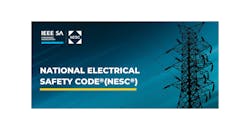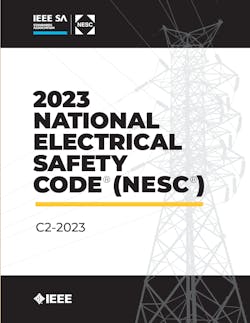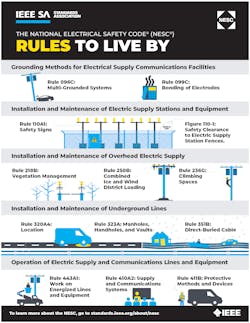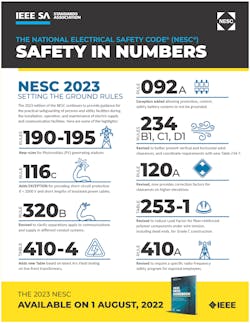Highlights of the New 2023 National Electrical Safety Code
Since 1914, the National Electrical Safety Code® (NESC®) has been the go-to safety standard for electric and telecom utility companies of all sizes and ownership of structures. Updated every five years, the 2023 edition of the NESC was released on Aug. 1, 2022, and it will become effective on Feb. 1, 2023. Edited and published by the IEEE Standards Association (IEEE SA), with the approval of the American National Standards Institute (ANSI), the NESC has contributed to major electrical safety codes in most states in the United States and other parts of the world.
The NESC sets the ground rules and guidelines for its primary focus: the practical safeguarding of utility workers and the public during the installation, operation, and maintenance of electric supply, communication lines, and associated equipment.
Adherence to the NESC is vast. Most of the outside plant networks of communications and power grid installations in the United States follow the NESC. Utilities use the NESC as the basis for their joint use agreements within state and local jurisdictions. Most, if not all, of the “make-ready work” — and its associated fees that telecom companies pay electric utilities to connect to their facilities and/or infrastructure — is largely based on installation and compliance requirements found in the NESC.
Format highlights
Like previous versions, the 2023 edition will be available in digital, printed, e-Learnings, redline versions, and mobile-app formats. The edition consists of initial sections covering scope, purpose, and grounding methods, followed by sections that include specific rules for electric supply stations, overhead lines, underground lines, and safety-related work practices.
A companion 2023 NESC Handbook, published at the same time as the Code, includes all the rules of the Code but also provides insights and commentary on the rules and how to apply them from the experts who helped develop the Code. The new handbook format will be more user-friendly, providing historical notes that give context for revisions and additions. The previous edition of the handbook (2017 edition) is available in Spanish and Chinese, and the 2023 handbook will be translated soon.
Another key improvement to the user experience — and to help prevent critical errors — are the notable changes made to units of measurement. All stand-alone tables for metric measurements have been removed from the main body and moved to Annex 1. For tables that include both English and metric values, the revised Code presents numerical values in the customary “inch-foot-pound” system first and the corresponding metric values following in parentheses. These and other changes were introduced to help prevent users from making serious errors caused by misreading a value as being metric when, in fact, they are U.S. values.
Structure and update highlights
The 2023 NESC is divided into several major sections. Following are highlights of revisions and additions:
- Section 1 [Scope and Purpose] – Several practical editorials, clarifications, and format revisions were made in Sec. 1 and throughout the Code to emphasize the primary focus as being the safety of persons, leaving the protection of facilities as a secondary benefit (Scope Rule 010). In addition, Rule 013 on the “Application of Rules to Existing installations and New Construction” was clarified to provide operational flexibility for maintenance replacements, adding facilities to existing poles/structures, and modifications to existing poles.
- Section 2 [Definitions of Special Terms] helps clarify the intent of the detailed rules throughout the NESC as well as maintain consistency across the Code.
- Section 9 [Grounding Methods for Electrical Supply and Communications Facilities] provides methods for grounding to help prevent injury that may be caused by differences in electrical potential. This section contains the means for grounding and bonding for communications equipment and where intersystem bonding (power and communications) is necessary (Rule 097).
- Part 1 (Sections 10-19) [Rules for the Installation and Maintenance of Electric Supply Stations and Equipment] covers protective arrangements and enclosures as well as rotating equipment (such as generators and motors), batteries, transformers and regulators conductors, circuit breakers, switches, fuses, switchgear, surge arresters, and other items encountered within a supply station. The explicit inclusion of grid-connected generation facilities in Part 1 of the 2023 Code included a major update to the battery rules (Sec. 14) and the addition of a new Sec. 19 for photovoltaic systems.
- Part 2 is divided into two sub-parts.
- Sections 20-23 [Overhead Lines- Clearances] define the organization and location of communication and supply conductors on the overhead facilities, clearances between conductors, structures, buildings, and the arrangement of circuits and associated overhead equipment and hardware. While it is recognized that physical protection is not practical or required for supporting structures located outside of established parking areas, alleys, or driveways, revisions in the 2023 NESC emphasize that every guy wire should be routinely marked at vulnerable or susceptible locations.
- Sections 24-27 [Overhead Lines - Strength and Loading] define various grades of construction and the corresponding storm loading and strength requirements for support structures and associated hardware as well as the conductors and messengers. Rules for power line insulators (including characteristics, mechanical strength, and application) are also included. For the 2023 Code, Sec. 25 and Sec. 26 were modernized by adding the most up-to-date wind maps from ASCE 7 and ASCE 74 (i.e., the 50- and 100-year MRI, or the Mean Return Interval, loading maps) as well as revising the rules for defining which construction grade (Table 242-1) is to be used for a given installation and application.
- Part 3 (Sections 30-39) [Safety Rules for the Installation and Maintenance of Underground Electric Supply and Communication Lines] provides requirements for cables and equipment deployed in underground, or direct buried systems as well as installations in tunnels. This section also covers where these facilities interconnect and terminate with equipment located at the ground surface or on poles.
- Part 4 (Sections 40-44) [Rules for the Operation of Electric Supply and Communications Lines and Equipment] addresses safe work practices for employees, including the responsibilities of employers, contractors, and host employers. Work rules on arc-flash protection, RF exposure management, and battery facilities were all updated and made more practical to match the latest technologies and facilities.
The 2023 NESC Handbook will include an appendix (Handbook Appendix 8) listing all the expected major changes.
Emerging technologies and substantive changes
As technology changes and evolves, so does the NESC. The 2023 NESC includes updates throughout, many of which address emerging technologies such as solar and wind energy, distributed energy/microgrids, batteries/energy storage, and wireless small cell networks. Notable updates and refinements to the code include:
- A new Sec. 19 covers photovoltaic generating stations, with sections addressing general codes, location, grounding configurations, vegetation management, DC overcurrent protection, and DC conductors. These new rules accommodate large-scale solar power projects.
- Significant revisions were made to Sec. 14 covering batteries. Previous editions of the Code were based on lead-acid technology and batteries only used for backup power. The 2023 Code incorporates the new battery technologies and addresses energy storage along with backup power.
- In the “Clearances” section, all rules for wireless antenna structures have been consolidated in the equipment section (Rule 238 and 239), which makes the Code more user-friendly.
SIDEBAR: Join Our Efforts
The 2023 NESC is the product of hundreds of contributors and peer reviewers and the careful editing of the IEEE Standards Association. To further address new technologies in subsequent editions of the Code:
- A new subcommittee was created focusing on generating stations, with the original subcommittee continuing to address substations.
- A working group is investigating Fault Managed Power Systems (FMPS) cables as the technology may be used for 5G networks. The team is looking at possible impacts including clearances and work rules.
We welcome your participation in these efforts. For more information, please visit standards.ieee.org where you can learn more.
About the Author
Ernesto Vega Jánica
Ernesto Vega Jánica serves as senior manager of opportunities development for the IEEE Standards Association. Recognized as the 2017 Fire Protection Engineer of the Year by the Society of Fire Protection Engineers (SFPE), New Jersey Chapter; and awarded the 2011 Tyco Patent Prize as the author of a patent application on visual fire alarm notification devices, Vega Jánica has authored multiple technical papers and international presentations in the engineering fields, as well as in applications of optimization models. He earned a Bachelor of Science in Electrical Engineering from Universidad del Norte and a Master of Science in Project Management from Escuela Colombiana de Ingenieria, in Colombia, South America, after which he earned a Master’s Degree in Fire Protection Engineering from the University of Maryland College Park. Vega Jánica is also an instructor of international standards.



